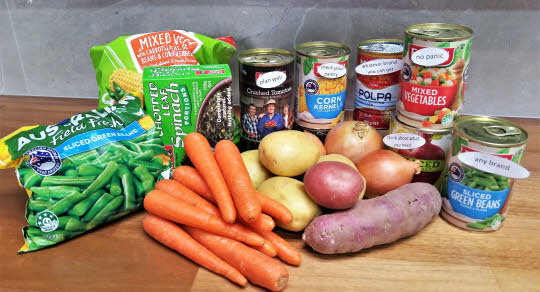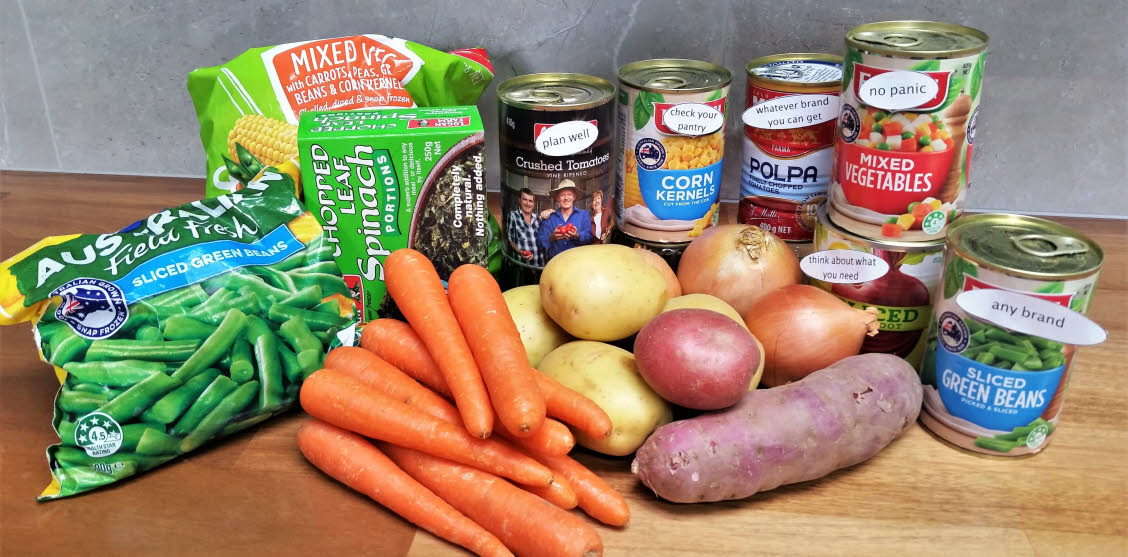 |
Tips on stocking vegetables in readiness for isolation or quarantine.
This is not a time to let your health slip so you need to be very flexible when shopping. This guide shows food swaps that help you keep your nutrition up.
If you are thrust into lock down or isolation, you should not go to the shops to pick up groceries. You need to be ready for no shopping for two weeks unless home deliveries to your front gate are available. But even this may not be a good option because not all items on your grocery list will be available. You could be left very short on vegetables.
Choose the best you can from what is left in the fresh produce area during your ordinary routine shop. Head to the freezer and canned vegetable section for vegetables that will store longer for use during isolation or quarantine.
If you are used to popping into shop every few days for fresh vegetables, the amounts shown below might seem huge but they are not. Once spaced out across a fortnight, they are just enough.
Some swaps may simply not be possible in your area but I have included them just in case they are.
Be prepared. You are not allowed to go to shops during quarantine or self-isolation.
Vegetables
1. Fresh vegetables have a variable shelf and fridge life. Buy to fit your fridge’s capacity. There is no point buying bags of fresh produce only to leave them sitting on the kitchen bench to wilt and wither away because the fridge is already full.
Buy uncut whole pumpkin, cabbage and potatoes. They keep longer than cut pieces.
Store whole pumpkin, onions and potatoes in the dark in a cool dry place. Exposure to light turns potatoes green with solanine. Do not eat green potatoes because they are toxic to humans. Light also stimulates sprouting of onion and potatoes. The skins of cooked potato, pumpkin and carrot are edible. Wash and scrub the dirt off before cooking but don’t worry about peeling them.
Prepare home made vegetables soups such as pumpkin soup and potato and leek soup for the freezer. Freeze into single-serves.
Buy alfalfa and bean sprout seeds to supplement fresh and raw produce. Any kids at home will enjoy watching the seeds transform into edible sprouts.
Store other vegetables in the fridge.
Use up leafy fresh vegetables during the first week of isolation of quarantine.
Plant vegetable seeds and seedlings for future use.
2. Most fresh vegetables don’t last 14 days so you will need a back-up of frozen, canned and dried vegetables.
Plain frozen vegetables are excellent sources of nutrition. As good as fresh. Better than wilted. The range might include: peas, beans, edamame, spinach, kale, cauliflower, onion, carrot, corn, capsicum, corn, winter mixed vegetables and more. Select whatever is available. They often take less time than fresh vegetables to cook. They are fast. There is no waste and no time needed for preparation.
Avoid frozen chips, wedges, gems, tempura coated vegetables and other pre-fried vegetables. If you want frozen spuds, frozen mashed potato is a better option as are trays of pre-roasted frozen vegetables.
Canned vegetables usually have salt added so don’t add more salt at home. They are already cooked. Drain and use them straight from the can unheated or briefly reheat. Avoid excessive reheating because heat destroys folate, an essential B vitamin. Pour contents of partly-used cans of vegetables into sealable tubs and refrigerate. Do not store food in opened cans.
Bottled vegetables include fermented cabbage, pickled onions, gherkins and Mediterranean style marinated vegetables such as chargrilled capsicum, artichokes and mushrooms. These add strong flavour to meals, salads and sandwiches are count towards your vegetable intake. Drain away and save excess oil from bottled vegetables to add to salad dressings and cooking.
Shelf-stable vegetable juice is a great stand-by item for the pantry. Use it to make soups, sauces and casseroles or as a straight drink. Most vegetable juices have tomato as the primary ingredient, which makes juices a brilliant source of carotene (vitamin A) but they lack the fibre of un-juiced vegetables. Shelf-stable vegetable juices do not need refrigeration until they are opened.
Dried vegetables are scarce. Dried seaweed (e.g. nori wrappers for sushi), dried green and yellow peas, lentils and legumes sit here. Dried onion, from the spice section, is a handy sprinkle-in addition for rissoles. Dehydrated potato (instant potato) is not an ideal product, nutritionally, but if that is the only potato you can get, it us useful for an emergency back-up.
Powdered dehydrated vegetables are even less common but a few shops may still have some. They are highly concentrated and used as an additive to soups, sauces, layered vegetable dishes, and smoothies. You don’t need to add much because they are super strong in flavour and nutrient value. The downside is they don’t reconstitute or work as plated stand-alone vegetables.
rice and pasta are not enough to keep you well
How much vegetable to buy, swap and serve?
Packets, cans and jars vary is size and you are at the mercy of what remains in the shop. These are approximate amounts that give you a guide when shopping.
Check your pantry before you shop for items in bulk. You may already have cans and bottles of vegetable buried in the pantry somewhere.
I don’t usually talk about food in weights but when food is rationed at the shops, you need a better idea of how much to buy. Close enough is good enough at this stage.
Vegetables are important sources of a range of nutrients that support your immune system. For one adult, aim for more than 400 g daily.
Each one of these amounts is enough to last an adult 1 week:
3.5 kg fresh vegetables (allowed more for waste with peeling or leaf removal)
OR
3 kg frozen vegetables or vegetable juice
OR
5 to 6 kg canned or bottled vegetables (This is the weight shown on packaging. In other words, before draining. It is not unusual for 40% to 50% of the weight to be throw-away liquid in canned vegetables. I have allowed for that)
OR
1.4 kg dry split peas, lentils or legumes.
Hopefully, we will continue to see a wide variety of fresh and frozen vegetables available so mix and adjust the amounts above to make up 2 weeks worth of vegetables.

enough for 2 weeks for one adult
Each one of the following combo examples is enough to last 2 weeks for one adult:
1 kg potatoes (white or sweet potato) + 4 onions + 700 g can tomatoes + 3 kg frozen vegetables (e.g. cauliflower, green beans, carrot, peas)
OR
500 g potatoes + 500 g pumpkin + 500 g carrot + 200 g fermented or pickled vegetable (e.g. sauerkraut) + 3 x 400 g cans vegetable (e.g. corn, asparagus, beans) + 500 g frozen corn cobs + 4 onions + 2 kg frozen mixed vegetables (such as winter mix or stir fry) + 300 ml vegetable juice
Adjust the proportions to suit your household preferences and what is available to buy, and what space you have in your freezer and fridge. You may need to alter your style of cooking and family meals to suit what is available.
Cans and bottles of vegetables do not need refrigeration until opened so you can store them in the garage if space is tight.
With frozen, canned and bottled vegetables at home, you are better prepared, food-wise and nutritionally, for any sudden need to enter isolation.
When choice is limited and food is rationed, close enough is good enough when it comes to amounts. We are at the mercy of our local shops and fellow shoppers. This is not a time to be choosy. Accept what is available and adapt your cooking and taste buds rather than go hungry. Please do not be greedy.
